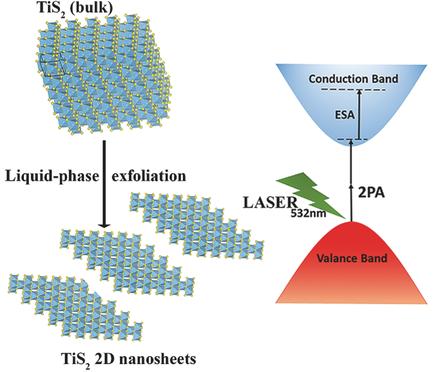当前位置:
X-MOL 学术
›
Adv. Opt. Mater.
›
论文详情
Our official English website, www.x-mol.net, welcomes your
feedback! (Note: you will need to create a separate account there.)
2D TiS2 Layers: A Superior Nonlinear Optical Limiting Material
Advanced Optical Materials ( IF 8.0 ) Pub Date : 2017-10-04 , DOI: 10.1002/adom.201700713 Sreekanth J. Varma 1 , Jitesh Kumar 1, 2 , Yang Liu 3, 4 , Katherine Layne 1, 2 , Jingjie Wu 3 , Chenglu Liang 3, 4 , Yusuke Nakanishi 3 , Amir Aliyan 5 , Wei Yang 4 , Pulickel M. Ajayan 3 , Jayan Thomas 1, 2, 6
Advanced Optical Materials ( IF 8.0 ) Pub Date : 2017-10-04 , DOI: 10.1002/adom.201700713 Sreekanth J. Varma 1 , Jitesh Kumar 1, 2 , Yang Liu 3, 4 , Katherine Layne 1, 2 , Jingjie Wu 3 , Chenglu Liang 3, 4 , Yusuke Nakanishi 3 , Amir Aliyan 5 , Wei Yang 4 , Pulickel M. Ajayan 3 , Jayan Thomas 1, 2, 6
Affiliation

|
The advancement in high power lasers has urged the requisite of efficient optical limiting materials for both eye and sensor protection. The discovery of atomically thin 2D transition metal dichacogenides with distinctive properties has paved the way for a variety of applications including optical limiting. Until recently, the optical limiting effect exhibited by 2D materials is inferior to the benchmark materials fullerene (C60) and graphene. This article reports the optical limiting activity of the 2D transition metal dichalcogenide, titanium disulfide (TiS2) nanosheets, using optical and photoacoustic z‐scan techniques. The 77% nonlinear optical limiting exhibited by the TiS2 sheets with 73% linear‐transmittance is superior to that of any other existing 2D dichalcogenide sheets, graphene, and the benchmark optical limiting material, C60. The enhanced nonlinear response is attributed to the concerted effect of 2‐photon and the induced excited state absorptions. By using photoacoustic z‐scan, a unique tool developed to determine the nonlinear optical limiting mechanism in materials, it is found that the optical limiting exhibited by TiS2 2D sheets and graphene are mainly due to nonlinear absorption rather than scattering effects. These results have opened the door for 2D‐dichalcogenide‐materials‐based highly efficient optical limiters, especially at low fluences.
中文翻译:

2D TiS2层:一种出色的非线性光学限制材料
大功率激光器的发展促使人们迫切需要有效的光学限制材料来保护眼睛和传感器。具有独特性质的原子级薄的2D过渡金属双金属卤化物的发现为包括光学限制在内的各种应用铺平了道路。直到最近,二维材料所表现出的光学限制效应还不如基准材料富勒烯(C 60)和石墨烯。本文使用光学和光声z扫描技术报告了2D过渡金属二硫化二硫化钛(TiS 2)纳米片的光学极限活性。TiS 2表现出77%的非线性光学极限线性透射率达73%的薄板优于任何其他现有的2D二卤化二硫化碳薄板,石墨烯和基准光学极限材料C 60。增强的非线性响应归因于2光子和诱导的激发态吸收的协同作用。通过使用光声z扫描(一种开发用于确定材料中非线性光学限制机制的独特工具),发现TiS 2 2D片材和石墨烯表现出的光学限制主要是由于非线性吸收而不是散射效应。这些结果为基于二维二卤化氢材料的高效光学限制器打开了大门,尤其是在低通量的情况下。
更新日期:2017-10-04
中文翻译:

2D TiS2层:一种出色的非线性光学限制材料
大功率激光器的发展促使人们迫切需要有效的光学限制材料来保护眼睛和传感器。具有独特性质的原子级薄的2D过渡金属双金属卤化物的发现为包括光学限制在内的各种应用铺平了道路。直到最近,二维材料所表现出的光学限制效应还不如基准材料富勒烯(C 60)和石墨烯。本文使用光学和光声z扫描技术报告了2D过渡金属二硫化二硫化钛(TiS 2)纳米片的光学极限活性。TiS 2表现出77%的非线性光学极限线性透射率达73%的薄板优于任何其他现有的2D二卤化二硫化碳薄板,石墨烯和基准光学极限材料C 60。增强的非线性响应归因于2光子和诱导的激发态吸收的协同作用。通过使用光声z扫描(一种开发用于确定材料中非线性光学限制机制的独特工具),发现TiS 2 2D片材和石墨烯表现出的光学限制主要是由于非线性吸收而不是散射效应。这些结果为基于二维二卤化氢材料的高效光学限制器打开了大门,尤其是在低通量的情况下。































 京公网安备 11010802027423号
京公网安备 11010802027423号